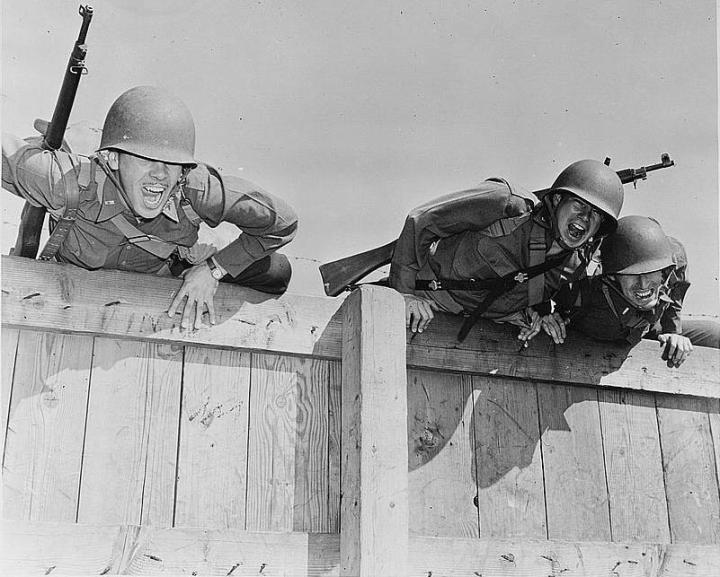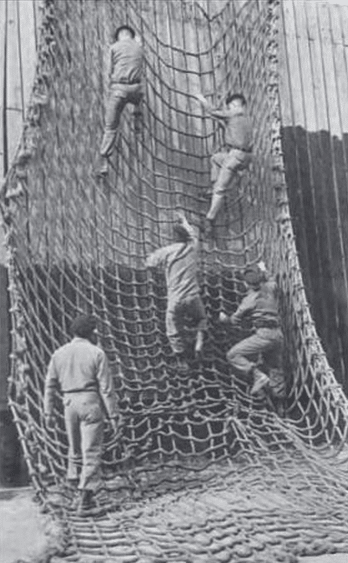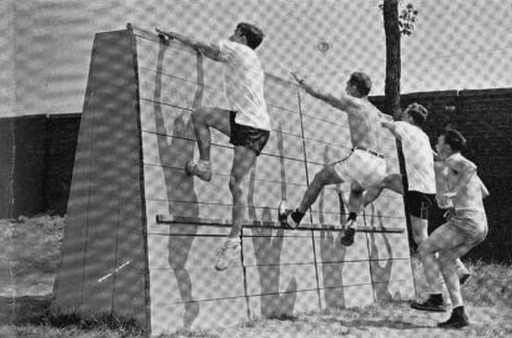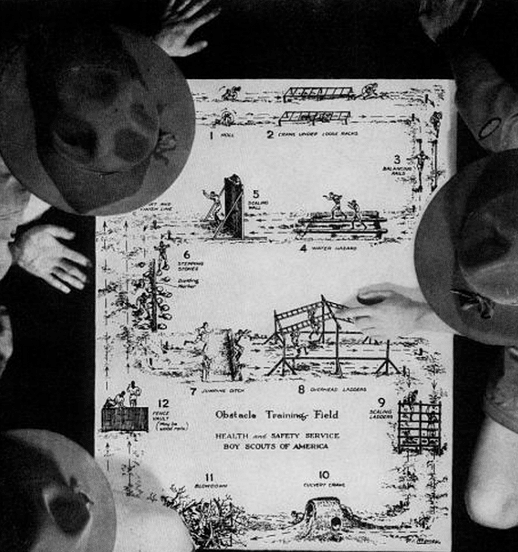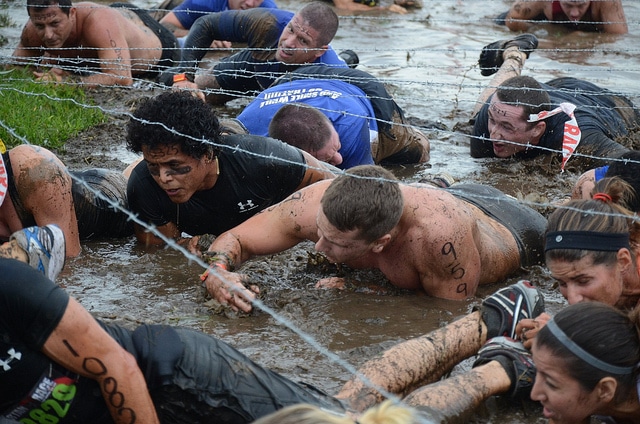For the past few years, you’d be hard-pressed to scroll through your Facebook feed, especially in the summertime, without seeing some of your friends posting pictures of themselves at the finish line of an obstacle course. Events like the Warrior Dash, Spartan Race, and Tough Mudder have become well-known parts of the modern recreational scene.
You might think these mud-filled tests of stamina, agility, and toughness represent a new cultural phenomenon, but their roots actually trace much farther back in history. Before becoming the proving ground for a kind of sport — a challenge for challenge’s sake — obstacle courses were used as training devices, designed to build the mental and physical fitness of soldiers, sailors, and marines preparing themselves for combat, as well as civilians interested in strengthening the whole man.
Georges Hebert and the Origins of Obstacle Courses
Obstacle courses, like almost everything else about physical culture, has it origins in the military and the building of better warriors.
The use of obstacle courses to train soldiers likely goes back to antiquity, though they were used in a less structured manner. Roman legionaries, for example, trained for battle by practicing jumping over natural barriers like hedges and ditches.
The rise of set, intentionally-constructed obstacle courses would largely have to wait until the 19th century. In Europe, this period saw a significant upswing of interest in physical fitness, which rose in tandem with feelings of nationalism that were surging in the continent’s respective countries. Frequent wars had shown nations like France, Britain, and Germany the necessity of keeping their peoples in fighting shape. Various schools of thought developed as to how best to do that, but most focused on gymnastics and functional exercises: running, calisthenics, jumping, climbing ropes, and using equipment like rings, the pommel horse, and parallel bars.

At the turn of the 20th century, Frenchman Georges Hebert got the idea of taking these different exercises and arranging them into a set obstacle course. Hebert had traveled the world in the French Navy and been impressed during a visit to Africa as to how “flexible, nimble, skillful, enduring, [and] resistant” the native peoples were, even though they didn’t follow any kind of formal exercise program. Hebert drew inspiration from this experience, as well as from ancient Greek and Roman culture, and the work of his physical education predecessors, in order to create his own fitness philosophy. “The Natural Method” encouraged its adherents to get strong and agile in the same way tribesmen had for thousands of years — practicing a diverse set of physical skills by moving through the natural environment and navigating varied terrains.
But Hebert also saw value in training on a permanent obstacle course, where one could practice these physical skills in a deliberate way. He thus created un parcours — courses on which “one walks, one runs, one jumps, one progresses quadrupedally [crawls], one climbs, one walks in unstable balance, one raises, one carries, one throws.” Hebert’s parcours — which included balance beams, walls, ladders, ropes and more — were designed not only to test a participant’s whole fitness, but to challenge and build their confidence, courage, willpower, resolution, and mental toughness. Running the course was not a timed event, but a way for each individual to work at bettering and improving themselves.

Hebert began to train the French Navy in his system, creating parcours de combatant on which sailors and marines could prepare themselves for battle. His work would continue during and between the two world wars, with his natural method becoming the standard system of French military physical education, and spreading to armed forces around the world. The idea of improving one’s mental and physical skills on obstacle courses proved popular with citizens as well, and his teachings inspired the building of civilian fitness trails, woodland challenge courses, confidence courses (which feature obstacles higher off the ground), and of course, the modern discipline of parkour.
American Military Obstacle Courses During the World Wars
The idea of obstacle course training for soldiers and sailors would migrate across the Atlantic and be implemented and modified by the American military during the 20th century’s two world wars.
Obstacle Courses in WWI
While it is often said General William Hoge introduced obstacle courses to the American military in 1941, doughboys had in fact trained on them during the First World War.

Obstacle courses were instituted as part of American soldiers’ training at the behest of Dr. Joseph E. Raycroft, former University of Chicago basketball coach and Chairman of the Department of Health and Physical Education at Princeton University. Raycroft served as an advisor to the Army, overseeing the physical fitness component of their training camps during WWI. The courses he designed aimed to strengthen a soldier’s stamina and agility, acquaint them with the kind of obstacles and physical skills they’d encounter in combat, and boost their overall confidence and resolution.
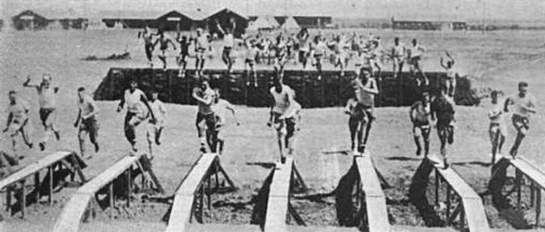
The exact layout and components of the course varied by training camp, but the 1917 manual, Army Field Physical Training of the Soldier, recommended that it be 100 yards long, with the following obstacles spaced out every 12 yards:
- 5-foot shallow ditch
- Row of low 2.5-foot hurdles
- Bar fence with a top bar adjustable from 3 to 4.5 feet
- Sand-bag wall 4.5 feet high
- Shallow ditch 8 feet wide
- 7-foot wall
- Elevated balance run 48 feet long
- 2.5-foot hurdle
After the war, Raycroft created a new manual — Mass Physical Training — which established the Individual Efficiency Test. The IET represented the first time the Army had created criteria by which to quantify and test its soldiers “all-around physical efficiency.” The test was designed to gauge a soldier’s combat readiness and consisted of a 5-round battery: 100-yard run (to be done in 14 seconds or less), running broad jump (12 ft), wall climb (8 ft. unassisted), hand grenade throw (30 yards into a 10′ diameter circle), and a timed Obstacle Course Run (OCR). (While the “R” in OCR has now become synonymous with “Race,” since soldiers ran against time, rather than each other, they were then called runs rather than races.) According to West Point professor Whitfield B. East, this OCR “was the first recorded use of an obstacle course to obtain quantitative assessment of functional fitness.” The course was 100 yards in length, included 5 obstacles, had to be finished in 30 seconds, and was conducted like so:
“Sprint 10 yards to a three-foot hurdle; sprint 15 yards to a smooth wire entanglement 10 feet wide (arms must be folded while crossing the entanglement; hands may not be used); sprint 15 yards to a ramp 5 feet high immediately joining which is a trench 10 feet wide and 3 feet deep; sprint 15 yards to a plank bridge 1 foot wide (over a shallow trench 20 feet wide); sprint 15 yards to an 8-foot smooth-faced fence; sprint to finish.”
Interest in physical fitness, both in the military and in the civilian population, always heightens during wars, and then ebbs between them. Thus during the interwar years of 1919-1939, the Army’s focus on the importance of soldiers’ physical prowess waned, and as a consequence, the Individual Efficiency Test was dropped from the military’s training program in 1928. While obstacle courses were no longer timed and used as part of the IET, they continued to be employed as a general training and fitness device, and were in use at the outset of WWII. But the Second World War would transform them into something more varied, interesting, and challenging.
Obstacle Courses in WWII

“Running, jumping, vaulting, climbing, and crawling are basic activities required of all soldiers. They are also excellent means for developing endurance, agility, confidence, and self-reliance. Instruction and training in these basic activities are best conducted on an obstacle course.” –FM 21-20: Basic Field Manual on Physical Training, 1941
WWI had shown that positional, trench warfare was largely over, and that the military had to adapt to a more mobile and stamina-demanding style of fighting. Yet when conscription was instituted in 1940, up to half of the millions of men who were called up for service were found to be physically unfit for duty. Colonel Ted Bank, chief of the Army’s athletics program, lamented the fact that:
“So many of our young men are being sent into our armed services without the ability to swim sufficiently to save their own lives, without the leg strength to allow them to jump combat obstacles, without the arm and shoulder strength which would enable them to pull themselves up over ledges, or save their own lives by climbing up or down ropes, and rope ladders…and without those agilities and skills developed by competitive sports, that would increase their chances of staying alive in war.”
Obstacle courses were, of course, the perfect tool to address these deficiencies. The type in use by the Army at the start of the war, however, was too mild for the task.

The OCR suggested in the 1941 edition of FM 21-20 (the Army’s physical training manual) was fairly tame; its rigor would be developed and heightened during the war.
And that’s where Lt. Col. William Hoge actually comes in. A West Point graduate, veteran of WWI, and holder of advanced degrees from MIT, Hoge was assigned in 1941 to command the Engineer Replacement Training Center at Fort Belvoir, Virginia. Once deployed to the front, his soldier-engineers would be required to build roads and bridges, clear and build obstacles, and rig demolitions — physically strenuous work. Hoge wanted to prepare his men for the tasks ahead, but with the camp located on a peninsula, space was at a premium. He had heard that the Germans — whose training was still influenced by the “natural method” — were using challenging obstacle courses that packed a big physical punch in a small space, and required the men to practice running, climbing, crawling, swinging, and jumping. So he set out to design a new OCR for American soldiers, one that was more strenuous than those used by the military previously.
In addition to tried and true elements like hurdles and walls, Hoge’s course required traversing a horizontal ladder (monkey bars), crawling through concrete pipes and under barbed wire, swinging over ditches, and crossing streams by balancing on a log. Hoge was constantly experimenting — tinkering with how to make the obstacles more challenging and introducing new ones, like climbing a 20-foot fireman’s pole and scaling an unstable cargo net. When Army Chief of Staff George C. Marshall visited Fort Belvoir and saw the course, he was so impressed that he instructed camps around the country to implement similar OCRs.
Obstacle course training was instituted, improved, and adapted throughout all the other branches of the armed forces as well.
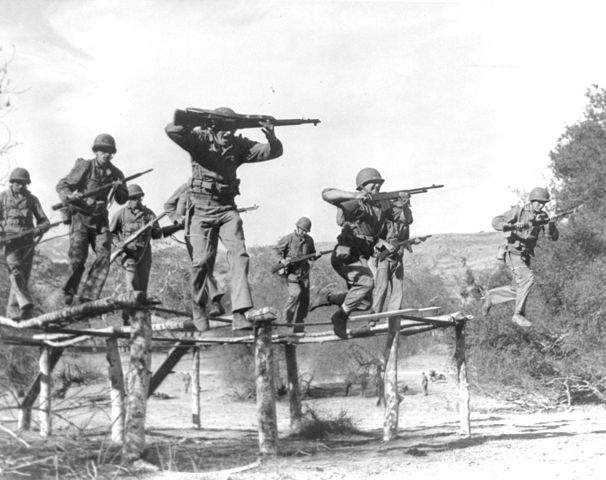
Marine Raiders — the first US Special Operations force to form and see combat in WWII — train on an OCR.
Obstacle course training not only became widely implemented in the armed forces, but made its way into civilian culture as well. Universities around the country sought to prepare their male (and sometimes female too) students for military service, and some instituted mandatory physical education classes.
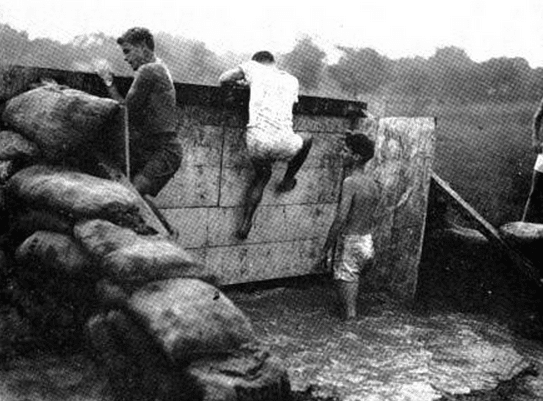
Princeton students navigate an obstacle course in 1943 as part of the university’s summer conditioning program. A pair of races between the undergrad track athletes and members of the school’s ROTC were held; the track stars won on the course their coach had built, but lost on the military-grade course the cadets typically trained on.
The University of Michigan, for example, required its male students to take a physical training course that consisted of three 90-minute sessions each week. Started in 1941, the program included calisthenics, track and field, team games, boxing, jiu-jitsu, wrestling, and, of course, an Army-style obstacle course.
Overseen by Coach H. O. Crisler, U-M’s Director of Athletics and Head Football Coach, the program was aimed at “toughening the bodies and developing the competitive spirit of America’s future soldiers and sailors.” (As an aside, it’s interesting to note the place of college football at the university back then; Michigan’s head coach had time not only to be the sport’s head coach, but to act as director of athletics, and oversee a university-wide physical fitness program!)
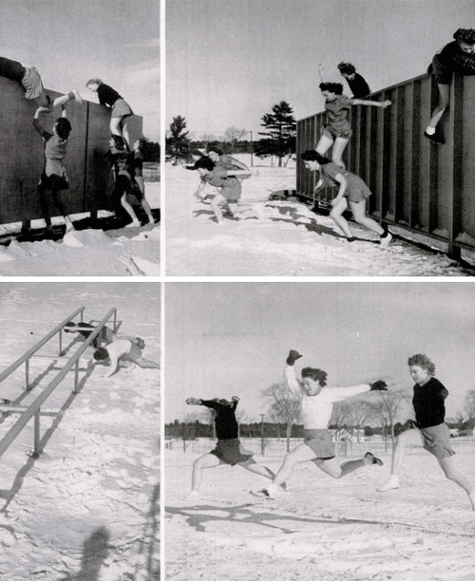
During the war, even the ladies got in on the obstacle course craze. The University of New Hampshire was the first school in the country to start a program akin to the men’s ROTC. Designed to prepare female seniors who planned on going into the WAAC, WAVES, and other auxiliaries of the armed forces after graduation, the program required 3 hours a week of training, including an obstacle course run. The OCR was the same as the one laid out in FM 21-20 for men, and the gals did it in the snow, in shorts, no less.
Obstacle course training was implemented not only at the college level but for high school students as well. The Victory Corps program prepared teenagers in skills they’d need to serve in the military, from engineering to physical fitness. The Victory Corps manual suggested constructing a rigorous military-style obstacle course for students to train on.
The Boy Scouts were also big proponents of the obstacle course, encouraging young men to build ones in their backyard and at summer camp. An article in a 1942 issue of Boys’ Life magazine suggested its readers construct the easy-to-build course below in order to “help toughen up every Scout in your Patrol and your Troop”; maybe it will give you some ideas for building your own backyard course!
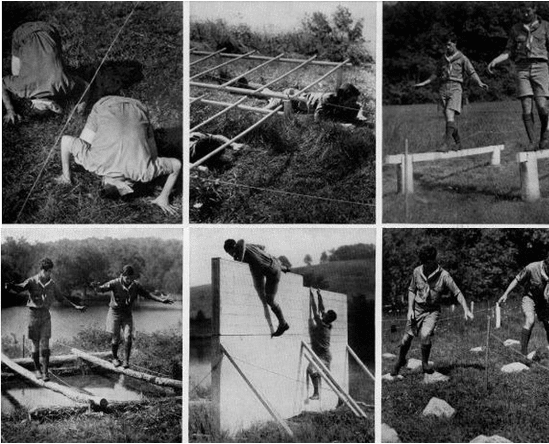
Starting from upper left and moving clockwise: 1) From the starting line, make a turn, then go into a roll. 2) The crawl rack is 12’ long, 5’ wide. If you knock down the loose cross bars, you must replace them and try again. 3) The balancing rails are made from 2” by 4” pieces, 14’ long. If you fall off you must start again. 4) The logs across the water hazard should be 14’ to 16’ long. A brook could form a natural obstacle. 5) Build a well-supported scaling wall, 7’ to 7.5’ high. Scaling the wall is a test of individual ability. No help permitted! 6) The stepping stones may actually be stones of uneven height, or they may be round blocks of wood.
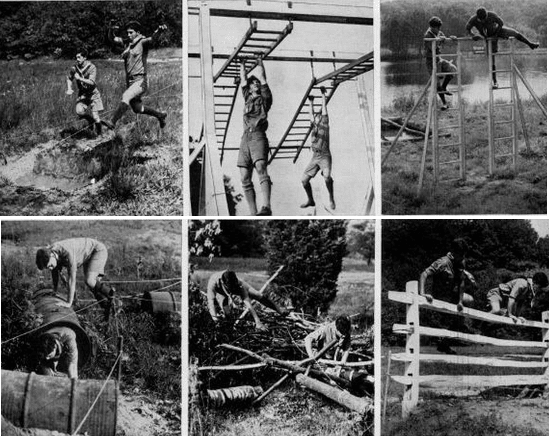
7) Make the jumping ditch 7.25’ wide. It can be shallow, but a deep ditch looks more like a real obstacle. 8) Each overhead ladder is 10’ to 12’ in length. Since each course has two of these ladders, contestants will do it twice. 9) The scaling ladder is 8’ high. Climb up with front to ladders, down with back to them. 10) In the culvert crawl, crawl through one barrel, jump over other. Competitors change courses. 11) The blowdown represents hurricane or bombing wreckage. The easier you take it, the quicker you make it. 12) The fence vault is 3.5’ high. Competitors jump it, run to their team mates who then start off.
After the end of WWII, all the armed forces kept obstacle courses as part of their basic training programs, and they remain a staple of the boot camp experience down to the present day. But interest in obstacle courses amongst the civilian population fell off precipitously after the war. High schools and colleges kept, and even increased, physical education requirements for students. But the options for fulfilling these requirements greatly expanded at many schools to include low-key intramural sports like bowling and badminton and recreational activities like canoeing, skating, fishing, and biking. Obstacle courses reminded people of the war, a memory the country wanted to move on from. Thus, besides from some notable exceptions, OCRs as a fitness-training tool fell out of favor, and courses around the country were left to rot, waiting to be rediscovered by a new generation interested in testing their toughness.
Obstacle Races as Intentional Challenge, Competitive Sport, and Weekend Diversion
Obstacle racing as a competitive sport — where being the fastest wasn’t a matter of pride or passing a physical fitness test — can be traced back to the steeplechase. Originally run as a cross-country race at the University of Oxford during the mid-19th century, the event eventually became standardized and run on a flat track.
But obstacle racing in terms of running a gnarly, varied, military-style course is essentially an innovation of our modern culture.
The roots of the phenomenon are typically traced to an event in the UK called the Tough Guy. Started in 1987 by eccentric former British army soldier Billy Wilson — aka Mr. Mouse — the 15-kilometer obstacle course is situated on a farm near Wolverhampton, England. Wilson specifically designed the course to induce fear and pain and to push participants to their very limits.
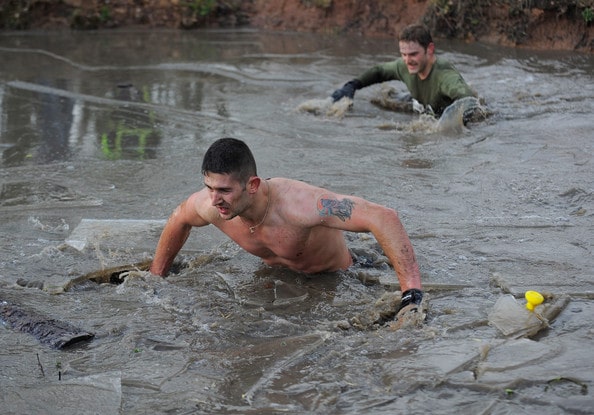
Run in freezing temperatures during the month of January, Tough Guy has so far seen two fatalities in its history. Up to a third of participants fail to finish, and even those who do, including the winners, often get hypothermia in the process.
In 2010, British Harvard MBA grad Will Dean launched the Tough Mudder, an obstacle event inspired by — some would say stolen from — the Tough Guy challenge. Two weeks after the first Tough Mudder was held, the first Spartan Race took place. Started by endurance athlete Joe De Sena, who had been holding grueling challenges on his farm in Vermont for several years prior, the Spartan Race differed from the Tough Mudder in that it was timed and competitive, whereas the Tough Mudder was centered on camaraderie and the simple goal of finishing the course. Rounding out what is now known as “the Big 3,” the Warrior Dash had begun a year earlier but with a different angle from its toughness-flouting competitors — it sold itself as a shorter, less strenuous race with more emphasis on having fun.
In the next few years, the obstacle race and mud run business positively exploded, and hundreds of OCRs joined the Big 3 in looking to attract the athletic and merely curious to their events. The idea of crawling under barbed wire and scaling walls for fun and sport rapidly went from fringe to mainstream, but the explosion had some rather murky consequences.
Some races tried to expand too fast, held poorly organized events, and went under. The bigger races became crowded, studded with long lines, and covered in corporate sponsorships and commercialization. Some courses were watered down both in number of obstacles and in their caliber in order to attract a broader swath of possible participants; obstacle course organizers are truly faced with a dilemma — how to make their courses tough enough that it feels like a challenging experience, without chasing away too many potential customers. This tension is reflected in many OCRs low retention rates; for example, only 20% of those who do a Tough Mudder end up doing another. Once the novelty is gone, a sense of been-there-done-that sets in, leaving people with less will and motivation to participate again in something both expensive and physically strenuous.
The potential for long-term profitability is another problem facing large-scale OCRs. While the Big 3 each make millions of dollars (Tough Mudder has brought in at least $100 million since its inception), each race can cost as much as $400k to put on, and the companies spend millions more on marketing to attract new participants. De Sena has been open about the difficulties of actually making money in the OCR business, saying Spartan Race hasn’t made a profit yet, but hopes to…by 2018.
Besides logistical and financial problems, OCRs have also been criticized for somewhat shady ethical practices, such as tacking hidden fees onto already high registration costs, the exploitation of volunteers (who are sometimes overworked for a pittance of a donation), and obscuring their connections with charities; their marketing makes it appear as if the company itself donates money to a non-profit, whereas they actually contribute nothing other than what participants raise themselves.
All in all, the modern OCR scene is not exactly the kind of thing Georges Hebert — who believed obstacle course training could build higher moral character — probably imagined.
The Future of Obstacle Racing
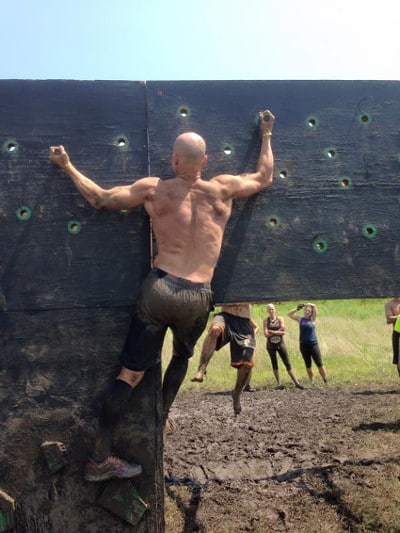
The future of obstacle races may lie in smaller, regional events. For my money, the best OCR in the country right now is Conquer the Gauntlet, a series based in the middle of the country that does pretty much everything right: reasonable prices, well-organized, smaller crowds, lots of challenging obstacles, and plenty of healthy competition.
Will obstacle course racing be another fad, or a lasting piece of contemporary physical culture?
Their recent surge in popularity points to both some flattering and not-so-flattering characteristics of our modern society.
Surely part of the appeal of OCRs is our incessant desire for novelty and our inherent narcissism. Once road races had become ho-hum, folks were looking for something new and exciting to try. And the fact that the event makes for such ready Facebook and Instagram fodder makes it all the more enticing.
But I think interest in OCRs will continue — if not at the high-level of the present, then in some form — even now that the shine’s worn off. For I don’t feel mere thrill-seeking, nor the desire to boast, completely explains the OCR phenomenon. I think people are earnestly dissatisfied with their comfortable, easy lives, and really do want to challenge themselves and take part in things that push their limits and put them in a little pain. Modern life doesn’t come with a lot of built-in difficulties, which forces us to seek them out ourselves. So, while there’s absolutely something patently ridiculous about the idea of people paying good money to crawl around in the mud and lug sandbags uphill, I personally like to operate by the “something is always better than nothing” principle; that is, doing something physical, outside, is better than spending the weekend on the couch as a spectator, watching football on television. When I’ve participated in OCRs, it often occurs to me that they’re essentially our modern hairshirt — the way we flagellate ourselves for enjoying a life of so much indulgent luxury. And a little penance is due, I think; in participating in an OCR — at least an actually difficult one — we make a physical offering to our ancestors, a pledge that we’re trying to do what we can to walk in their footsteps and not be a complete blob.
All of which is to say, OCRs will likely continue to exist as long as society remains relatively free of physical hardships. Once an actual, suffering-inducing crisis arrives, we’ll stop doing obstacle courses for fun and personal challenge…and start doing them to prepare to tackle an external challenge! Because any way you slice it, when it comes to galvanizing the whole man — building your strength, stamina, agility, confidence, and all-around toughness — no training tool truly compares.
Want to share your thoughts on this article? Send us a tweet or join the discussion on Facebook!


